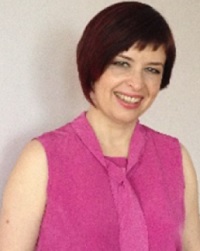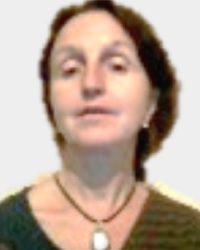Budapest Workshop Day
2nd of October 2015
TIMETABLE
8.45. Arrival, registration, changing clothes
9.15. Opening
| Time |
Workshop |
Facilitator |
| 9.30 |
Amazon Journeys.
Building Resilience in Palliative Care through DMT interventions |
Jeannette MacDonald |
| 11.00. |
BREAK |
| 11.20. |
Dances of the Moon: exploration of femininity in Dance/Movement Therapy groups for women |
Irina Biryukova,
Julia Morozova |
| 12.50. |
LUNCH |
| 14.20 |
Experience and Movement – Me and the Other.
Hungarian PMDT in practice |
Márta Merényi,
Katalin Vermes |
| 16.50. |
BREAK |
| 17.20 -18.50 |
A Phase Model of Growth in DMT |
Susanne Bender |
19 -19.30 Closing
Venue: SÍN Culture Centre, 10. Gyutacs street, 1139 Budapest.
Map: http://en.sinarts.org/maps-directions/
Jeannette MacDonald
Amazon Journeys. Building Resilience in Palliative Care through DMT interventions
Palliative care is an important field of care for the DMT profession now and, more especially, in the future as demographic data reveals aging populations. As wounded healers we confront lifelong themes of loss allowing us to join our clients in the dances we create together. Through this experience we may develop strategies for reinforcing and building upon the latent resilience that resides within. As a dancer, therapist and cancer survivor I am aware, personally, of the rich opportunities within DMT to express the lived experience of confronting our own mortality and transforming our existential fears into a love of life. Today we will move towards a symbolic or metaphoric motif. The use of symbols and metaphors in dance movement therapy arises from dance as an art form, elegantly described by dance movement therapist Rosemarie Samaritter, (Samaritter 2009). Respecting the fact that clients in the group might have very different cultural and life experience backgrounds I like to use archetypal metaphors or symbols from nature such as, mountains, rivers, trees, wind, rain, sun etc. as they are universally recognised and imbued with personal meaning. Symbolically we are consistently a group of Amazon warriors on a personal quest or journey.
“Dance/movement therapy, drawing from a strong theoretical base, as well as a rich body of experiential work, offers integrative support to individuals experiencing physical degradation and confronting their mortality.” Abstract from a paper by Dillenbeck & Hammond-Meiers, (2009)
Jeannette MacDonald 
Trained at the Royal Ballet School, London. She danced professionally in Europe and the UK before pioneering her work with dance in the UK National Health Service. She created the first post as a Dance Movement Therapist within the UK National Health Service and continued to develop the profession within the health service over a 38 year career. Jeannette teaches and lectures nationally and internationally and is currently core tutor on the DMT Masters Course, Codarts, Rotterdam where she also holds the Group Process. She is visiting lecturer for Masters’ Courses in Barcelona, Warsaw and Zagreb. She has published a number of book chapters and peer reviewed articles and continues to maintain a private therapy, supervision and consultancy practice. She is a regular contributor to national and international conferences. Jeannette is a member of the Executive Council of ADMP UK and a Senior Associate Member of the Royal Society of Medicine. Jeannette maintains strong links with the dance profession and is a Life Member of the Royal Academy of Dance and a Practical Teaching Supervisor on its teaching courses.
Irina Biryukova – Julia Morozova
Dances of the Moon: exploration of femininity in Dance/Movement Therapy groups for women
Femininity remains a focus of attention in psychotherapy through the years. The topics of this exploration can vary from search for the archetypic roots of the Feminine and Masculine to gender roles change in the modern society.
In this workshop we want to share our experience of working with DMT groups for women dedicated to exploration of femininity to encourage women in big cities to reconnect with their nature, creativity, strength and power and beauty that live inside.
The sensitivity to the cyclic changes in nature and in the body, embracing the changes that life and ages bring, trust the Wisdom of the body, finding the feminine power and strength are the themes that could be explored at such group and during our workshop.
Irina Biryukova 
BC‐DMT, CAGS is a dance movement psychotherapist, clinical psychologist in private practice with over 20 years of experience. She is the head of a DMP Programme of the Institute of Practical Psychology and Psychoanalysis in Moscow.
Julia Morozova 
dance/movement therapist in private practice, educator and supervisor. Board officer (communications and PR) of EADMT.
Márta Merényi – Katalin Vermes
Experience and Movement – Me and the Other. Hungarian PMDT in practice
In the workshop we work with the changing attention directed to the body, movement and perception. Our goal is to experience how the psychotherapeutic body-movement process builds up from these simple movement-based situations.
In Hungary the methodology of Psychodynamic Movement and Dance Therapy (PMDT) have been developed from the 1980s, originally with the aim of treating psychosis and severe personality-somatic disorders.
PMDT is a method based on the psychoanalytical approach, which builds on theories of early development (Stern, BCPSG, Demos, Fogel, Lachmann, Beebe, Fonagy, Target etc.).
According to these theories in the early mother-infant relationship the ability of the infant develops through subtle bodily emotional interactions in order to perceive and later
regulate his/her own states. The basic condition of the development of this ability is the emotional availability of the mother (or the primary caretaker) and her responsiveness to the infant’s signals. Therefore, the infant can get his/her way around his/her own sensations and states, and become able to actively participate and influence his/her relationships.
PMDT reaches down to the layers of this early infantile experience through mobilizing the bodily-movement memory – the so-called implicit memory – and this way our nonconscious and unconscious emotions, memories might become available.
The body-movement process is built on movement improvisation facilitated by the movement group leader/therapist. During the body-awareness work we focus on the change and movement of certain states of the body; we experience the movement itself and we are also aware of what is happening.
As this state of mind develops, our sensitivity to emotions and the deepest layers of relationships enhances. In this state of mind early relationship patterns are reactivated and become available to be worked through and reframed. In PMDT both individual and relationship-based work are essential. Movement improvisation – individually, in pairs and groups – is built on working with body awareness. As self-perception and relationships become more sophisticated during the movement group process, the movement improvisation develops into a creative process.
Verbal discussion and reflections also has great importance in this psychodynamic methodology.
Márta Merényi 
Psychiatrist, psychoanalytically oriented psychotherapist, trainer of psychodynamic movement and dance psychotherapy. Founder of psychodynamic movement and dance therapy in Hungary.(PMDT).
As a medical student she played in the Movement Theatre of University of Technology Budapest. Márta began to elaborate the PMDT method in the 80s working with psychotic patients in the National Institute of Psychiatry and Neurology. Applying the method to the therapy of severe personality disorders she developed the practice and theory of PMDT.
She established the Hungarian Association for Movement and Dance Therapy (HAMDT) in 1992 together with some colleagues. In the past decades HAMDT became a prospering professional community, several movement and dance psychotherapists, group leaders and trainers work together on the continuous development of PMDT method.
Katalin Vermes 
PMDT group leader and trainer of Hungarian Association for Movement and Dance Therapy. She has led psychodynamic movement and dance therapy groups for seventeen years and taught in PMDT training for a decade.
PhD, associate professor of philosophy at University of Physical Education, her field of research is the phenomenology of the body. She has published several articles and a book about philosophical and psychoanalytical interpretations of corporeity (A test éthosza – The Ethos of Body L’Harmattan 2006). Delegate of Hungarian Association for Movement and Dance Therapy in EADMT.
Susanne Bender
A Phase Model of Growth in DMT
In order to offer adequate individual or group interventions, the dance/movement therapist needs a model for personal and group development and growth. The presented cyclic four phase model of growth (inclusion, responsibility, openness, termination) is based on systems theories and a major extension of Will Schutz’s FIRO (Fundamental interpersonal relations orientation) Model. Each phase demands another therapeutic approach. The related issues are life themes (i. e., Do I belong? Do I feel competent? Can I build and hold intimate relationships? Do I know how to let go?) that each person has to deal with in different phases of his or her life.
Participants will have an opportunity to experience the growth model in depth by exploring DMT interventions addressing the issues of each phase. Case examples will help them to analyze each phase. Particpants will explore the importance of the individual’s place in the inclusion phase. They will experiment with the expression of boundaries and strength in the responsibility phase and emotional expression in the openness phase, and find rituals to structure the termination phase. Participants will become sensitive to a variety of therapist’s styles in each phase.
Learning objectives:
- Participants will be introduced to this growth model through experiental learning and lecture.
- At the end of this seminar the participants will understand the importance of music in each phase (i.e. structured, simple music in the inclusion phase) and will be able to choose appropriate music for each phase.
- Based on concepts of the Kestenberg Movement Profile, Laban Movement Analysis and systems theory, participants will be able to identify client resources and support them in solving life issues.
- At the end of this seminar the participants will be sensitive to the variety of different therapist styles in each phase.
References:
Bender, S. (2014). Systemische Tanztherapie. München: Ernst Reinhardt.
Kestenberg Amighi, J.; Lewis, P.; Loman, S. & Sossin, M. (1999). The meaning of movement: Developmental and clinical perspectives of the Kestenberg Movement Profile. Amsterdam: Gordon and Breach.
Luhmann, N. (1996). Social systems. Palo Alto, CA: Stanford University Press.
Schutz, W. (1984). The truth option. Berkeley: Ten Speed Press.
Yalom, I. (1995). Theory and practice of group psychotherapy. New York: Basic Books.
Susanne Bender 
Dance Therapist, M.A. Trainer, Supervisor BTD, ECP (European Certificate of Psychotherapy), Family and Couples Therapist, Special Education Teacher, author of numerous books. Since 1987, she is the director of the European Center for Dance Therapy, EZETTHERA, an accredited DMT training institute; since 2010 the director of the China-Germany Professional Dance Therapy Training Program in Beijing, China. In over 30 years, she has worked in several psychiatric and special education settings, has taught at the University of Cologne and Riga, and in 2007 and 2010 she has organized Moving from Within, International Congress on Movement Analysis in in Education, Therapy and Science. She is the former president of the BTD and a former German delegate EADMT.







